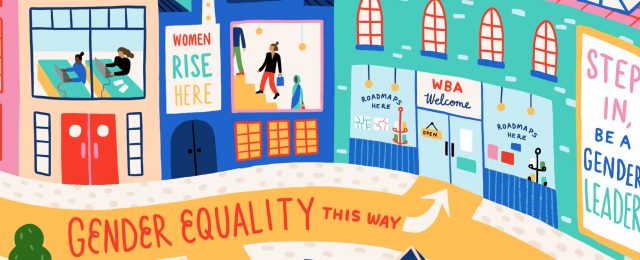Make invisible women visible: the roadmap to gender equality and women’s empowerment

Gender-based discrimination remains a persistent issue globally. Women are underrepresented in leadership positions, with women accounting for 21% of board directors and 15% of senior executive positions of the 2,000 most influential companies globally. They are paid less than their male colleagues, they participate less in the labour force and spend more time on unpaid care and domestic work. They face sexual harassment and gender-based violence. They receive limited support for their health needs. And these inequalities have only been deepened by the COVID-19 pandemic, widening the gender gap even further. Yet, the business case is clear: advancing gender equality has the potential to increase global growth by $12 trillion by 2025. See who these 2,000 companies are
Now, more than ever, there is a need to take action to close the gender gap, and companies are uniquely positioned to do so across their entire value chains. However, to begin to do so, we need to understand the problem.
Gender data is invisible
Apparel companies provide the ideal starting place for understanding the complex web of issues that must be overcome. The sector plays a critical role in driving gender equality and women’s empowerment, with more than two thirds of its 60–75 million global workforce being women.
WBA’s Gender Baseline Report reveals that corporate progress toward gender equality is almost invisible. The Report assesses the world’s 36 most influential apparel companies on how they promote and drive gender equality and women’s empowerment across their value chain to determine progress on SDG 5 and beyond. It sheds light on corporate gender impacts – a first step all too often missing – so that progress can be made in closing the gender gap. The 36 apparel companies included in this assessment are disclosing less than 40% of the information that stakeholders, according to our research, expect to see both in terms of quality and quantity of information shared. Moreover, nearly 90% of the companies assessed disclose less than 30%. Go to baseline report
But here lies the first challenge, apparel companies are characterised by substantial outsourcing to multiple levels of suppliers, hiding the true scale of their workforce. This model exacerbates the problems facing women, as most suppliers are based in developing countries where women often face gender discrimination, fewer workplace protections and, where legal protections exist, weaker levels of enforcement. This gives rise to more challenging and discriminatory working conditions, including fewer formal contracts, lower wages, unpredictable working hours, increased health and safety issues, poor or non-existent maternity protection, a lack of childcare support, gender-based violence and harassment, and weaker collective bargaining opportunities.
Accordingly, when it comes to gender equality, companies need to be concerned with solving these underlying problems, rather than simply alleviating them. But how can they do so when they don’t have the data to identify their impacts on women? We have found that the 36 apparel companies assessed are not disclosing enough regarding their gender efforts.
Furthermore, even on the aspects of their value chain they do report on, sex-disaggregated data is particularly low across several metrics. These include the gender composition of company leadership, the gender pay gap, and the gender breakdown of key grievance data, such as the number of grievances reported and remediated. In the supply chain, only VF Corporation requests suppliers to disclose sex-disaggregated data for both their employees and operators. No company publishes the sex-disaggregated data on injuries, fatalities and absenteeism of workers in the supply chain. No company publishes the sex-disaggregated data on the total procurement spend that is directed to women-owned businesses.
This is significant, because without an understanding of the extent of gender inequalities, corporate action cannot be truly effective.
It’s time to drive transformative change
The global pandemic has highlighted the importance and urgency of taking action for gender equality. The UN issued a warning highlighting the “aggravated impacts of COVID-19 for women already living on the economic margins.”
But, not just any change is needed – transformative change is vital to drive gender equality and women’s empowerment. If companies shifted their approach from avoiding gender-related issues and disclosing just what is legally required to proactively addressing inequalities, then wider social change could be achieved. Achievement of gender equality has the power to break the cycle of poverty. For example, ensuring that women are paid living wages for their labour can contribute to the fulfilment of a range of human rights, including the rights to food, water, health, adequate housing, education and so on. Accordingly, it is critical that companies lead this change rather than follow.
A strategic approach to gender is the way forward
The achievement of gender equality and women’s empowerment by business is fundamental to building a sustainable future that leaves no one behind. However, the pathway to achieving gender equality is not a straightforward one. It requires business to take an integrated and holistic approach across their entire value chain that considers the various dimensions affecting gender equality (e.g. representation, compensation and benefits, health and well-being, violence and harassment). Only then can companies truly drive gender-transformative and sustainable change.
While WBA’s Gender Baseline Report shows that apparel companies must do better almost every company included is taking action in some respect to drive gender equality and women’s empowerment. Our task is to accelerate these corporate efforts. To get the world to where it needs to be, we need to empower women who make up more than half of the global population. The solution starts with making the invisible, visible. To do so, we need to think differently, act differently, and build differently to ensure that businesses, countries, economies and individuals can all thrive.